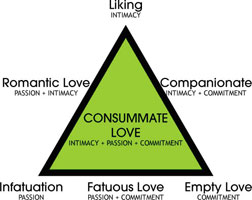In the fall I took a psychology of human sexuality course with Dr. Pamela Landau. Thus far, it’s the best class I’ve had here, and I came out with a very different perspective on people, relationships, and myself—and an inability to see the Simplex-brand exercise equipment in my neighborhood fitness center without thinking of herpes. Part way through the term, we discussed Robert Sternberg’s triarchic theory of love. It’s based on a triangle:

Each point represents an aspect of love—intimacy, passion, and commitment—as well as the form of love associated with only that aspect; each leg represents a combination of the forms at its ends, and in the center is the blend of all three.
I say I’m between projects right now, but that’s not quite right. I’m between projects with which I’m in consummate love. Here’s a sampling of what I do have:
1. A fully-drafted novel. I completed the first draft in December of 2010 and got about two-thirds of the way through a first heavy revision before becoming distracted by life (a poor excuse, I know). I would say this project and I have a romantic relationship: I feel close to it, and I care about it … but I haven’t committed, and I don’t know if I can.
2. A partially-drafted novel. I started this one more recently and got maybe a third of the way through. It’s hard to say, though, because I never developed a good sense of the thing as a whole—which I suspect is why I drifted away from it. This I think would fall under infatuation, because it’s a project I was excited about and, if I returned to it, could see myself being excited about again. But I don’t have that level of intimacy yet, and I haven’t even committed a full draft to (digital) paper.
3. A partial short story. I don’t know where it’s going, and although I started strong, now every time I open the document, I plod along through a few half-hearted paragraphs before becoming bored. Still, it’s what I’ve been working on, so I keep working on it. This is clearly empty love—lacking intimacy and passion, at this point little more than a way to be writing something.
4. A concept for a story about an android with an autocorrect function. This seems to me like fatuous love, because I’ve held onto the idea for a while and I find it enjoyable … but I haven’t gone any deeper than that conceptual surface level.
5. A draft of a short story. It’s drawn very heavily from my own life, so there’s a great deal of intimacy, but I think all there is to our writer-writing relationship is liking. I look at it and consider revising it but feel no particular drive to, and I don’t picture myself going anywhere with it.
In life, a relationship drifts around in the triangle as the dynamic changes. The writer Edith Wharton speaks to the writer-writing relationship drift when she says, “What is writing a novel like? 1. The beginning: A ride through a spring wood. 2. The middle: The Gobi Desert. 3. The end: A night with a lover.” (She goes on to add, “I am now in the Gobi Desert.”) I see the same thing in my own writing, and I worry about being dissuaded by Gobi fatigue.
Perhaps what I need to do right now is to take some time to examine myself as a writer. Writing without having more deliberate intentions seems sort of like wandering into the Gobi Desert, blindfolded and wearing impractical heels. If writing is building a relationship, I ought to treat it with the same care I would any other relationship.
Or, perhaps, even more.
Leave a Reply